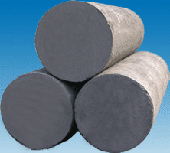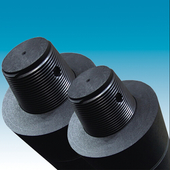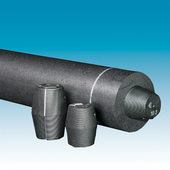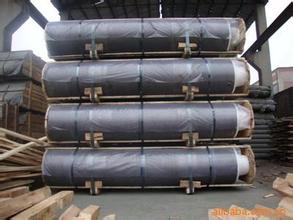History and Categories of Graphite Electrodes



Graphite electrode is a kind of high-temperature resistant graphite conductive material, made of petroleum coke, pitch coke as granular material, coal pitch as binder through kneading, forming, roasting, graphitization and machining processing. Graphite electrode is an important high temperature conductive material for EAF steelmaking. The electric energy is input to the EAF through graphite electrode. The high temperature generated by EAF between electrode end and charge is used as the heat source to melt the charge for steelmaking.
In 2000, the world consumed about 1 million tons of graphite electrode, and the consumption of China is about 250,000 tons. With excellent physical and chemical properties of graphite electrode, it is widely used in other industrial departments. Carbon products industry, which is mainly produce graphite electrode, has become an important part of present raw material industry.
Brief History
As early as 1810, Humphry Davy used charcoal to make carbon electrodes generate EAFs after being energized, opening up a broad prospect of using carbon material as high-temperature conductive electrodes. In 1846, Stair and Edwards mixed coke powder and sucrose, form under pressure and baked at high temperatures to produce another kind of carbon electrode,which was dipped in concentrated sugar water to increase bulk density. They obtained patent right to produce this electrode.
In 1877, C.F.Brush and W.H.Lawrence of Cleveland, successfully developed low-ash carbon electrode by calcined petroleum coke.
In 1899, O.G. Pritchard first reported the method of making natural graphite electrodes from Ceylon natural graphite as a raw material. In 1896, H.Y. Gastner patented the use of electricity to heat carbon electrodes directly to high temperatures to produce artificial graphite electrodes with better performance than natural ones.
In 1897, E.G. Acheson of Carborundum Co. produced the first batch of artificial graphite electrodes with petroleum coke as raw material in the resistance furnace to produce carborundum. Its specifications were 22mm×32mm×380mm. The artificial graphite electrodes were used in electrochemical industry to produce caustic soda. The "Acheson" graphitization furnace designed on this basis consist of a carbon electrode produced from petroleum coke and a small amount of resistance material (metallurgical coke particles) to form a "furnace core resistance". After high temperature was generated, the carbon electrode made of petroleum coke was "graphitized" to obtain artificial graphite electrode.
Frenchman P.L.T.Heroult invented the direct EAF furnace and began to be used for calcium carbide and ferroalloy production at the end of 19th century. It was first used for steelmaking in 1899. The EAF required a certain number of high-temperature conductive electrodes. Although Acheson Graphite Co. sold connectable electrodes around 1900, only small graphite electrodes could be produced at this time.
In the early 20th century, EAF steelmaking mainly used carbon electrodes with anthracite as raw material or natural graphite electrodes with natural graphite as raw material. The process of producing carbon electrodes or natural graphite electrodes was relatively simple.
Carbon electrodes with a diameter of 610mm had been supplied to the market in 1910. However, the excellent performance of graphite electrodes, the continuous improvement of manufacturing processes, the mass production of large-size graphite electrodes and the continuous decline in prices, the EAF steelmaking industry had gradually switched to graphite electrodes, and the use of carbon electrodes or natural graphite electrodes was gradually reduced.

After 1960s, most EAFs used graphite electrodes for steelmaking.
The maximum diameter of graphite electrodes made from in 1914~1918 was only 356mm.
Graphite electrodes with a diameter of 406 mm were produced in 1924. In 1930, it was expanded to 457mm, then increased to 508mm in 1937. Large-scale graphite electrodes with diameters of 559mm, 610mm, 660mm, 711mm, and 762mm were soon produced.
In 1980s, the graphite electrode diameter was 813mm being used in the world's largest steelmaking EAF. After World War II, the quality of raw materials, equipment and manufacturing process for graphite electrodes production have been continuously improved. With the increasing demand of input power of EAF steelmaking, high-power and ultra-high-power graphite electrodes were successfully developed in 1960s and 1970s.
Due to the continuous improvement of graphite electrodes quality and the improvement of EAF steelmaking process, graphite electrodes consumption per ton of EAF steel had been reduced from 6-8kg in 1970s to 4-6kg (ordinary power EAF) in 1980s. The the large EAF ultra-high power graphite electrode consumption had been reduced to about 2.5kg per ton of steel, while that of the ultra-high power DC EAF (with only one graphite electrode) was reduced to about 1.5kg per ton of steel. At 1980s end, the tonnage of most EAF steelmaking industry of the developed countries in the world had increased to 80-200 tons, so a large number of high-power or ultra-high-power graphite electrodes with a diameter of 550-750mm were used.
Varieties
According to the different raw materials used and physical and chemical indexes difference of the finished product, graphite electrodes can be divided into three categories: regular power graphite electrodes (RP grade), high power graphite electrodes (HP grade) and ultra-high power graphite electrodes (UHP grade). In 1980s, because graphite electrodes are mainly used for EAF steelmaking as conductive materials, the international EAF steelmaking industry classified EAF into three types according to the input power of transformer per ton of furnace capacity: regular power EAF (RP furnace), high-power EAF (HP furnace) and ultra-high-power EAF (UHP furnace). The power per ton RP furnaces capacity above 20 tons is about 300kW/t; HP furnace is about 400kW/t; the input power below 40 tons is 500~600kW/t, 50~80 tons is 400~500kW/t, above 100 tons is 350-450kW/t, which is called UHP furnace.
By the end of 1980s, the developed countries eliminated a large number of small and medium-sized RP EAF below 50t. Most of the newly built EAFs were large-scale UHP EAFs of 80-150t, and the input electric power was increased to 800kW/t. In the early 1990s, some UHP EAFs were further increased to 1000~1200kW/t. Graphite electrodes used in HP and UHP EAFs operate under more demanding conditions.
No related results found








0 Replies